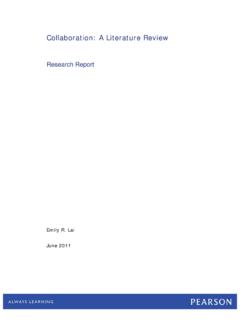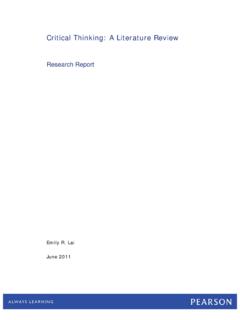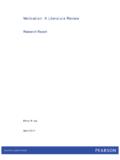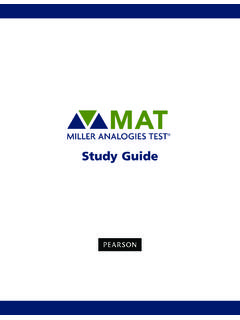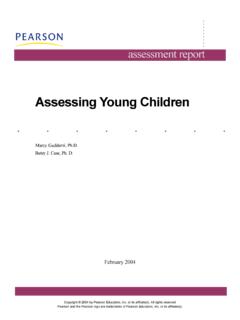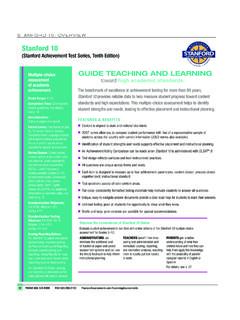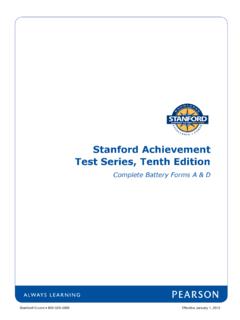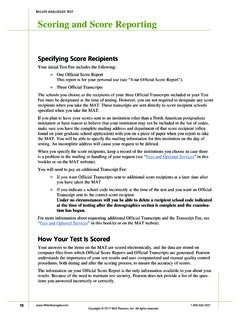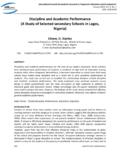Transcription of Motivation: A literature review
1 motivation : a literature review Research Report Emily R. Lai April 2011 motivation 1 About Pearson Pearson, the global leader in education and education technology, provides innovative print and digital education materials for preK through college, student information systems and learning management systems, teacher licensure testing, teacher professional development, career certification programs, and testing and assessment products that set the standard for the industry. Pearson s other primary businesses include the Financial Times Group and the Penguin Group.
2 For more information about the Assessment & Information group of Pearson, visit About Pearson s Research Reports Pearson s research report series provides preliminary dissemination of reports and articles prepared by TMRS staff, usually prior to formal publication. Pearson s publications in .pdf format may be obtained at: motivation 2 Abstract motivation refers to reasons that underlie behavior that is characterized by willingness and volition. Intrinsic motivation is animated by personal enjoyment, interest, or pleasure, whereas extrinsic motivation is governed by reinforcement contingencies.
3 motivation involves a constellation of closely related beliefs, perceptions, values, interests, and actions. motivation within individuals tends to vary across subject areas, and this domain specificity increases with age. motivation in children predicts motivation later in life, and the stability of this relationship strengthens with age. Traditionally, educators consider intrinsic motivation to be more desirable and to result in better learning outcomes than extrinsic motivation . In general, children appear to enter school with high levels of intrinsic motivation , although motivation tends to decline as children progress through school.
4 Research suggests that motivation can be manipulated through certain instructional practices, although studies demonstrate both positive and negative effects. The use of rewards may either encourage or diminish motivation , depending on the type of rewards and the context in which they are given. Teachers should attempt to give students more autonomy or control over their own learning by allowing them to make choices and use collaborative or cooperative learning approaches. In addition, teachers should create a supportive classroom environment with respect to goal structures, attributions, and external evaluation.
5 There are several challenges to assessing motivation , especially in children. Recommendations for eliciting evidence of motivation for assessment purposes are made. Keywords: motivation , intrinsic, extrinsic, self-efficacy, values, interests, goals, attributions motivation 3 Acknowledgements The author would like to thank Janet Fowler for assistance in conducting literature searches and the following reviewers for their helpful comments and suggestions on an earlier draft of this paper: Bob Dolan, Debbie Hamilton, Jadie Kong, and Kathleen McDonnold.
6 motivation 4 motivation : a literature review Educational psychologists have long recognized the importance of motivation for supporting student learning. More recently, the Partnership for 21st Century Skills has identified initiative as one of the life and career skills necessary to prepare students for post-secondary education and the workforce. However, many educators may be unfamiliar with methods for evaluating and encouraging motivation , particularly at the elementary level. The purpose of this literature review is fourfold: (a) to explore the ways in which motivation has been defined by researchers, (b) to investigate how motivation develops, (c) to learn how teachers can encourage development of motivation in their students, and (d) to review best practices in assessing motivation .
7 Definition of motivation motivation refers to the reasons underlying behavior (Guay et al., 2010, p. 712). Paraphrasing Gredler, Broussard and Garrison (2004) broadly define motivation as the attribute that moves us to do or not to do something (p. 106). Intrinsic motivation is motivation that is animated by personal enjoyment, interest, or pleasure. As Deci et al. (1999) observe, intrinsic motivation energizes and sustains activities through the spontaneous satisfactions inherent in effective volitional action. It is manifest in behaviors such as play, exploration, and challenge seeking that people often do for external rewards (p.)
8 658). Researchers often contrast intrinsic motivation with extrinsic motivation , which is motivation governed by reinforcement contingencies. Traditionally, educators consider intrinsic motivation to be more desirable and to result in better learning outcomes than extrinsic motivation (Deci et al., 1999). motivation 5 motivation involves a constellation of beliefs, perceptions, values, interests, and actions that are all closely related. As a result, various approaches to motivation can focus on cognitive behaviors (such as monitoring and strategy use), non-cognitive aspects (such as perceptions, beliefs, and attitudes), or both.
9 For example, Gottfried (1990) defines academic motivation as enjoyment of school learning characterized by a mastery orientation; curiosity; persistence; task-endogeny; and the learning of challenging, difficult, and novel tasks (p. 525). On the other hand, Turner (1995) considers motivation to be synonymous with cognitive engagement, which he defines as voluntary uses of high-level self-regulated learning strategies, such as paying attention, connection, planning, and monitoring (p. 413). Theoretical Approaches According to Stipek (1996), early approaches to the study of motivation were rooted in the literature on extrinsic reinforcement.
10 Within this literature , all behavior, including achievement, was believed to be governed by reinforcement contingencies. Proponents of this approach included Skinner, who identified different types of reinforcers. Positive reinforcers, or rewards, are consequences that increase the probability of a given behavior they were made contingent on, whereas negative reinforcers are consequences that increase the probability of a given behavior by removing or reducing some negative external stimulus. Punishment, on the other hand, refers to unpleasant consequences that decrease the probability of a given behavior.
